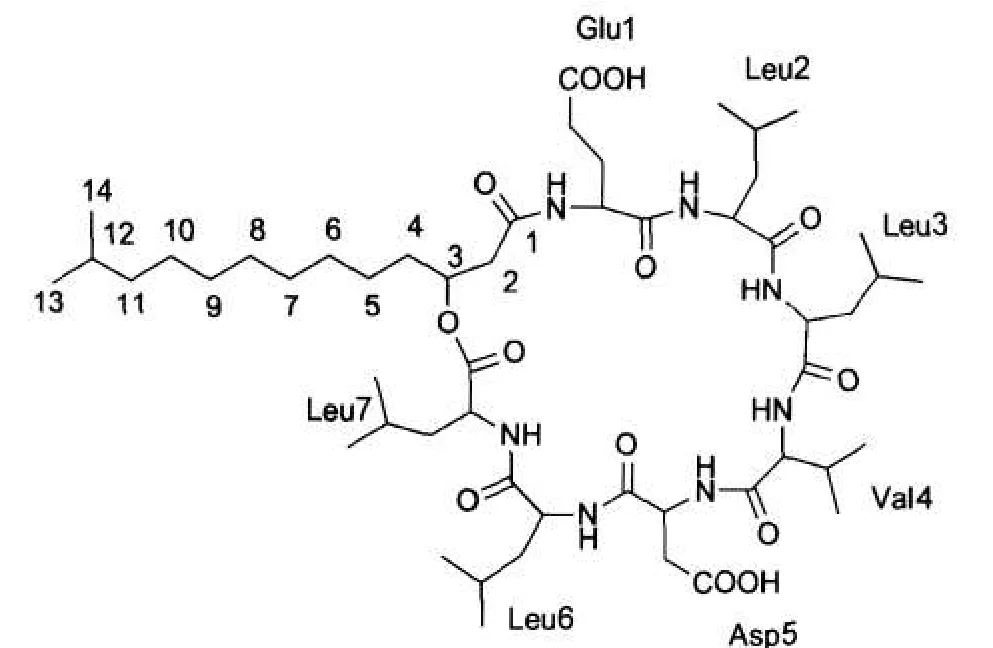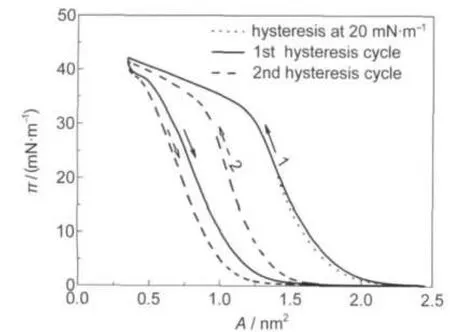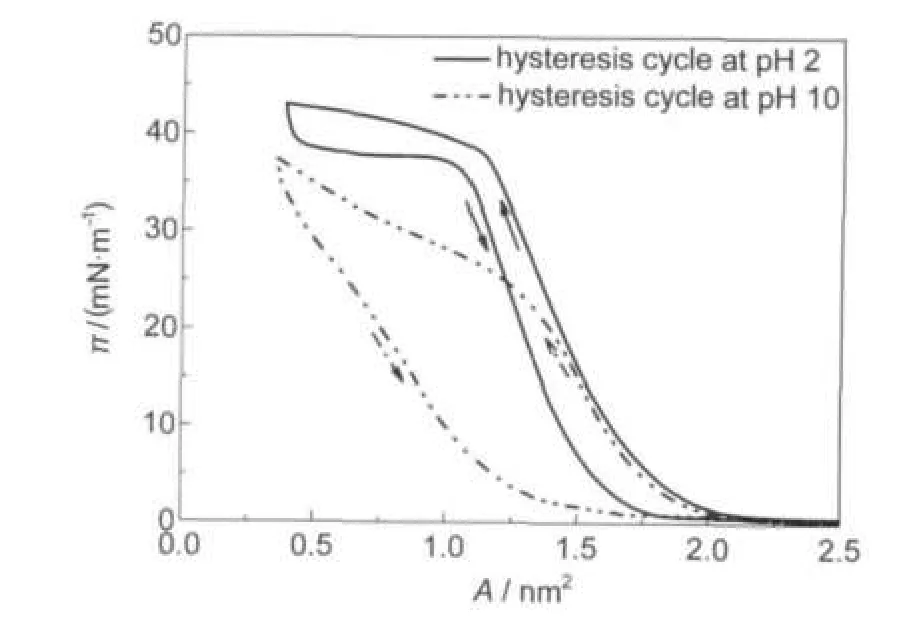表面活性素单分子膜在空气/水界面的迟滞现象
杨 莹 宋昌盛,2 叶汝强 牟伯中,*
(1华东理工大学应用化学研究所,上海200237;2太仓出入境检验检疫局,江苏太仓215400)
表面活性素单分子膜在空气/水界面的迟滞现象
杨 莹1宋昌盛1,2叶汝强1牟伯中1,*
(1华东理工大学应用化学研究所,上海200237;2太仓出入境检验检疫局,江苏太仓215400)
表面活性素是一类具有较强表面活性的微生物脂肽类化合物,能在空气/水界面形成不溶性单分子膜.利用Langmuir膜天平测定了表面活性素单分子膜的压缩-扩张循环曲线,发现单分子膜在经历了“平台区”后出现较大的迟滞环,迟滞环的形状与亚相pH有关.将“平台区”的单分子膜转移到云母表面后,用原子力显微镜(AFM)和扫描电子显微镜(SEM)均观察到高度达几十至数百纳米的表面聚集体,说明表面活性素在单分子膜的“平台区”伴随着自聚集.研究结果表明,表面活性素单分子膜在空气/水界面的迟滞现象是分子浸入亚相和形成三维表面聚集体共同作用的结果.
压缩-扩张循环;迟滞环;原子力显微镜;扫描电子显微镜;表面聚集体
1 Introduction
Surfactin is a fascinating group of lipopeptides produced by Bacillus subtilis.1Because of its exceptional surface activities,1-4and peculiar biological properties,5-7surfactin has a broad potential application in many fields,such as cosmetics,food additives,pharmacy,and oil recovery.8,9The structure of surfactin (Fig.1)contains a hydrophilic peptide loop of seven amino acids bonded to a linear hydrophobic fatty acid chain,10and consequently it exhibits amphiphilic behavior which is one of the main forces for self-assembly.11,12It is presumed that its biological activities,such as cytolytic property,5antiviral and hemolytic activities,6and the ability to inhibit formation of fibrin clots,1are a direct consequence of the interaction of surfactin with its target membrane.13To study the interactions between surfactin and biomembrane molecules,it seems important to study the structures and properties of surfactin and its analogues.An interest in the behavior of surfactin layers on water is due to the fact that the surface activity and biological property mostly occur at interfaces.14,15
Several authors have experimentally investigated the interfacial behavior and molecular organization of surfactin at the air-water interface.4,16-18Maget-Dana and Ptak16firstly reported the interfacial behavior of surfactin.They found that there existed a“plateau region”in the compression isotherm during which the peptide loop of surfactin molecule would adopt a vertical orientation.Based on dark-field electron micrographs of single-layer Langmuir-Blodgett(LB)film of surfactin, Ishigami et al.4proposed that surfactin molecules would rather promote the formation of inhomogeneous multilayer films in three dimensions at high surface pressure.The interfacial behavior of surfactin analogues has been investigated by Eeman et al.17It was found that a more hydrophobic alkyl chain induced a higher surface pressure and the opening of the peptide ring reduced the maximal surface pressure.The plateau regions in isotherms were observed for all samples they used.On the basis of atomic force microscopy(AFM)observation for single-layer LB film,18it appears that surfactin film would transit from monolayer to multilayer during the“plateau region”.According to computer simulation of surfactin conformation at a hydrophobic-hydrophilic interface,Gallet et al.15suggested that some molecules would be organized into clusters or twodimensional micelles during the“plateau”transition.While the plateau is usually considered to be related with the conformational changes in the polar moiety,19,20the origin of the“plateau region”in surfactin monolayer is still unclear.

Fig.1 Primary structure of surfactinApeptide loop containing seven amino acid residues bonds to a β-hydroxylfatty acid chain with 14 carbon atoms,denoted as SuC14in the context.
In order to obtain information on molecular behavior of surfactin during the“plateau region”,hysteresis behavior was studied and surface morphologies of single-layer LB films were observed by AFM and scanning electron microscopy (SEM).The contribution of surface-to-bulk diffusion and formation of three-dimensional surface aggregates to the hysteresis loop were also discussed.
2 Experimental
2.1 Materials
Surfactin samples used in the experiment were produced by Bacillus subtilis HSO121,21the isolation,purification,and structural analysis were conducted in our laboratory.22The surfactin with a β-hydroxyl fatty acid chain of 14 carbon atoms (denoted as SuC14)was collected by a semipreparative reversed-phase high performance liquid chromatography (HPLC),and its structure was determined by electrospray ionization quadruple-time-of-flight mass spectrometry(ESI QTOF MS),electroionization gas chromatography/mass spectrometry(EI GC/MS)combined with amino acid analysis and analytical HPLC.Hexane(≥99.0%)and chloroform(≥96.0%) were purchased from Shanghai Reagent Factory.
2.2 Surface pressure-molecular area(π-A) isotherm and preparation of LB films
The π-A isotherms were recorded by a computer-controlled film balance(612D,Nima Technology,England).Surfactin was spread onto subphase from its hexane/chloroform(2:1,V/ V)solution with the concentration of 1 mmol·L-1.The subphase was water purified with a Hitech-Kflow system(resistivity 18 MΩ·cm,pH~6),its pH was adjusted with hydrochloric acid or sodium hydroxide and its temperature was controlled by a water bath.After 30 μL of the stock solution was spread, the monolayer film was maintained without compression for at least 15 min to ensure the complete evaporation of the solvents and then compressed by barriers with a speed of 0.1 nm2· min-1·molecule-1.For hysteresis measurements,a 10 s delay was used following each compression or expansion step,prior to the next compression or expansion.Each of the isotherms was performed three times and the isotherms were reproducible.
Surfactin LB films were prepared by vertical dipping method.At the plateau region in the isotherm,where the change in area with change in surface pressure was large,the pressure control feedback was difficult to control.23Therefore,the films were transferred onto the freshly cleaved mica by the molecular area control.When molecular area reached 0.8 nm2·molecule-1,the LB film was deposited at a speed of 2 mm·min-1.
2.3 AFM and SEM imaging

Fig.2 Hysteresis cycles of SuC14monolayer on pure water(pH 6)at 25°C The solid and dashed lines,labeled with 1 and 2 respectively,are two consecutive hysteresis cycles at full expansion. The dotted lines are the hysteresis at 20 mN·m-1.
Atomic force microscopy(AJ III,Aijian Nanotechnology, China)was used to observe the surface morphologies of LB films.All AFM measurements were performed at room temperature(20°C)in tapping mode,using silicon cantilever(Mikro-Masch Company,Estonia)with a resonance frequency in the range of 240-400 kHz,and a spring constant of 48 N·m-1.The AFM images were obtained with a maximum scan range of 18 μm×18 μm and the scan rate was 1-2 Hz.All images were gained from at least three macroscopically-separated areas on each sample,and at least two independent samples of each type were prepared and observed.
The LB films were also observed by scanning electron microscopy(JSM-6390A,JEOL,Japan)after being gold-coated.
3 Results and discussion
3.1 Hysteresis loop
Fig.2 shows the compression-expansion cycles of surfactin monolayer on pure water at 25°C.The dotted line exhibits the hysteresis at a lower surface pressure(20 mN·m-1).Two consecutive hysteresis cycles at full trough expansion are shown as the solid and dashed lines,labeled with 1 and 2,respectively.All cycles present the same feature:the expansion isotherm curves are all under the compression curves.However,there is a larger hysteresis at full trough expansion as compared to that expanded at the lower pressure.The 2nd cycle is shifted towards smaller molecular areas than the 1st cycle.

Fig.3 Hysteresis cycles of SuC14monolayer on acidic subphase (pH 2)and alkaline subphase(pH 10)at 25°C
We also studied the hysteresis cycles of surfactin monolayer on acidic subphase and alkaline subphase(shown in Fig.3).All these hysteresis cycles present similar characteristics:as the monolayers expanded,a sharp drop in the surface pressure is observed.With subphase pH decreased,hysteresis loop becomes smaller and the expansion isotherm curve undergoes a pseudo plateau.It is presumed that the difference results from the surface-to-bulk diffusion of molecules during the plateau region.At low pH,the peptide loop can be hardly ionized.As the pH increases,the peptide loop in surfactin tends to be ionized,and the increase of hydrophilicity leads some molecules to submerge into subphase.The solubilization and chain reorganization processes of molecules require time to return to their surface-adsorbed state at expanded areas.24The“loss”of some molecules at interface at expansion areas induces lower surface pressure.
3.2 Surface morphology studies
To obtain information on the molecular behavior of surfactin in the plateau region,surfactin films were imaged by AFM after LB deposition.
Fig.4 shows the representative AFM topographic images of SuC14LB films prepared at the subphase pH 2,6,and 10.The LB films were all transferred at the plateau region.At pH 2, regular spheres shown in Fig.4A are observed.The diameters of these spheres are in a scale of hundreds of nanometers,the heights range from tens to hundreds nanometers.At pH 6,the AFM image(Fig.4B)shows quasi-circular aggregates,and the size distribution is similar to that observed in Fig.4A.At pH 10,the number of aggregates is greatly decreased(Fig.4C). However,with the addition of calcium cations into the alkaline subphase,more aggregates which were bigger and higher were observed(Fig.4D).

Fig.4 Top viewAFM images of single-layer SuC14LB film deposited at the plateau regions on water subphase(A)pH 2,(B)pH 6,(C)pH 10,(D)pH 10(containing calcium cation).All LB films were transferred at the pressure to which molecular area reaching at 0.8 nm2·molecule-1.

Fig.5 SEM images of single-layer SuC14LB film deposited at the plateau regions on water subphase(A)pH 2,(B)pH 6,(C)pH 10(containing calcium cation).All LB films were prepared at the conditions as same as forAFM observations.
To reveal further details on the distribution of particles observed by AFM,all LB films,which were prepared at the conditions as same as for AFM observations,were characterized by SEM.The SEM micrographs are presented in Fig.5.At pH 2 and 6,homogeneous distributions of circular particles are observed,with the diameter of(393±52)and(371±101)nm,respectively.The particles in Fig.5C exhibit a much larger size but fewer amount compared with those in Fig.5(A,B).No particles are observed by SEM for LB film prepared on alkaline subphase(pH 10)(data not shown),which is probably due to the low contrast between the targets and background.
The correspondence between the AFM images and SEM micrographs reveals that it would be a general phenomenon for surfactins that three-dimensional structures are formed in the plateau regions(for SuC13and SuC15,similar plateau regions and three-dimensional molecular particles are also observed, data not shown).For SuC14,the hydrophilic segment in molecule structure consists of a peptide loop of seven amino acids with two carboxyl residues(Glu1 and Asp5 in Fig.1).Several studies have proven that there exists hydrogen bond in surfactin molecules.4,15,26At low subphase pH,where the solubilization of surfactin molecule is low,the π-A isotherm shows a higher transition pressure reflecting the strong tendency of surfactin spreading on the subphase surface,and the protonation of the carboxylic moieties causes a reduction in both intra-and inter-molecular electrostatic repulsions,allowing a tighter closepacking of the alkyl chains at the interface,25and three hydrogen bonds in the most stable surfactin conformation assembled in monolayer15would be strengthened.Consequently molecules in Langmuir monolayer would pile up into supramolecular structures at high lateral pressure.When subphase is adjusted to pH 6 which is the pK(dissociation constant)of surfactin at interface,16the carboxyl groups are partially deprotonated, partial loss of surfactin molecules from the interface during the compression would occur besides the formation of supramolecular structures at high lateral pressure.At pH 10,the solubility of surfactin in water increase with ionization of the peptide loop,16which would induce molecules submerging into the subphase.On the other hand,the ionization of the peptide loop would greatly reduce the inter-and intra-molecular hydrogen bonds and hence surfactin molecules can hardly aggregate into supramolecular structure.However,the addition of calcium cations into the alkaline subphase would neutralize the two acidic amino residues and reduce electrostatic repulsions resulted from the ionization of the peptide loop.
4 Conclusions
The hysteresis behavior of surfactin monolayer on water subphase with different pH values and the LB film morphologies on mica substrates were investigated in this study.When compression cycle reached a plateau region at higher surface pressure,the expansion cycle showed a sharp drop in the surface pressure.With subphase pH decreased,hysteresis loop became smaller and the expansion isotherm underwent a pseudo plateau.AFM and SEM images of LB films at plateau region indicated that,when peptide loop in molecule structure was protonated or partially ionized,surfactin in monolayer could pile up into three-dimensional surface aggregates with the heights range from tens to hundreds nanometers.However,when peptide loop was fully ionized,surfactin in monolayer would prefer to submerge into subphase.Based on above findings,it is proposed that the formation of three-dimensional surface aggregates during the high-pressure transition induces the large hysteresis loop in surfactin monolayer,which is also attributed to the submergence of molecules into subphase when the peptide loop is ionized.The results presented here,concerning the hysteresis behavior in surfactin monolayer,provide new insights into the interfacial behavior of the amphiphilic lipopeptide.It is believed to be important to understand peculiar properties.
However,when examining LB film by AFM and SEM,it is difficult to fully determine whether the observed structure is a characteristic of the original monolayer on water or a result of structural change upon the film transfer.As a result,in situ technologies,such as Brewster angle microscopy and in situ infrared spectroscopy,would be applied to acquire structural information at the molecular level in future.
(1)Arima,K.;Kakinuma,A.;Tamura,G.Biochem.Biophys.Res. Commun.1968,31,488.
(2) Deleu,M.;Razafindralambo,H.;Popineau,Y.;Jacques,P.; Thonart,P.;Paquot,M.Colloids Surf.A 1999,152,3.
(3) Morikawa,M.;Hirata,Y.;Imanaka,T.Biochim.Biophys.Acta 2000,1488,211.
(4) Ishigami,Y.;Osman,M.;Nakahara,H.;Sano,Y.;Ishiguro,R.; Matsumoto,M.Colloids Surf.B 1995,4,341.
(5) Bernheimer,A.W.;Avigad,L.S.J.Gen.Microbiol.1970,61, 361.
(6) Vollenbroich,D.;Pauli,G.;Ozel,M.;Vater,J.Appl.Environ. Microbiol.1997,63,44.
(7) Kracht,M.;Rokos,H.;Ozel,M.;Kowall,M.;Pauli,G.; Vater,J.J.Antibiot.1999,52,613.
(8) Desai,J.D.;Banat,I.M.Microbiol.Mol.Biol.Rev.1997, 61,47.
(9) Schaller,K.D.;Fox,S.L.;Bruhn,D.F.;Noah,K.S.;Bala, G.A.Appl.Biochem.Biotechnol.2004,115,827.
(10) Yang,S.Z.;Wei,D.Z.;Mu,B.Z.J.Biochem.Biophys. Methods 2006,68,69.
(11) Lang,S.Curr.Opin.Colloid Interface Sci.2002,7,12.
(12) Terheiden,A.;Rellinghaus,B.;Stappert,S.;Acet,M.; Mayer,C.J.Chem.Phys.2004,121,510.
(13) Grau,A.;Gomez-Fernandez,J.C.;Peypoux,F.;Ortiz,A. Biochim.Biophys.Acta 1999,1418,307.
(14) Infante,M.R.;Moses,V.Int.J.Pept.Protein Res.1994,43, 173.
(15) Gallet,X.;Deleu,M.;Razafindralambo,H.;Jacques,P.; Thonart,P.;Paquot,M.;Brasseur,R.Langmuir 1999,15, 2409.
(16) Maget-Dana,R.;Ptak,M.J.Colloid Interface Sci.1992, 153,285.
(17) Eeman,M.;Berquand,A.;Dufrene,Y.F.;Paquot,M.; Dufour,S.;Deleu,M.Langmuir 2006,22,11337.
(18) Song,C.S.;Ye,R.Q.;Mu,B.Z.Colloids Surf.A 2007,302, 82.
(19) Youm,S.G.;Paeng,K.;Choi,Y.W.;Park,S.;Sohn,D.;Seo, Y.S.;Satija,S.K.;Kim,B.G.;Kim,S.;Park,S.Y. Langmuir 2005,21,5647.
(20) Islam,M.N.;Kato,T.J.Chem.Phys.2004,121,10217.
(21) Lü,Y.N.;Yang,S.Z.;Mu,B.Z.Microbiology 2005,32,67. [吕应年,杨世忠,牟伯中.微生物学通报,2005,32,67.]
(22) Liu,X.;Haddad,N.I.A.;Yang,S.;Mu,B.Protein Pept. Lett.2007,14,766.
(23) Alonso,C.;Alig,T.;Yoon,J.;Bringezu,F.;Warriner,H.; Zasadzinski,J.A.Biophys.J.2004,87,4188.
(24) Zhu,J.;Eisenberg,A.;Lennox,R.B.Macromolecules 1992, 25,6547.
(25) Petriat,F.;Giasson,S.Langmuir 2005,21,7326.
(26) Song,C.S.;Ye,R.Q.;Mu,B.Z.Colloids Surf.A 2008,330,49.
May 17,2011;Revised:June 29,2011;Published on Web:July 11,2011.
Hysteresis Behavior of Surfactin Monolayer at the Air/Water Interface
YANG Ying1SONG Chang-Sheng1,2YE Ru-Qiang1MU Bo-Zhong1,*
(1Institute of Applied Chemistry,East China University of Science and Technology,Shanghai 200237,P.R.China;
2Taicang Entry-Exit Inspection and Quarantine Bureau,Taicang 215400,Jiangsu Province,P.R.China)
Surfactin,one of the most surface-active microbial lipopeptides,can readily form an insoluble monolayer at the air/water interface.Consecutive compression-expansion cycles of surfactin with a β-hydroxyl fatty acid chain consisting of 14 carbon atoms were studied by a Langmuir film balance.A larger hysteresis loop was observed when the compression isotherm reached a plateau compared with that expanded at a lower surface pressure(20 mN·m-1).The 2nd cycle was shifted towards smaller molecular areas compared with the 1st cycle.We also studied the hysteresis cycles of the surfactin monolayer on subphase of different pH values.With a decrease in the subphase pH the hysteresis loop became smaller and the expansion isotherm curve underwent a longer pseudo plateau.Furthermore,the morphologies of the surfactin monolayers in the plateau region,which were transferred onto a mica surface,were characterized by atomic force microscopy(AFM)and scanning electron microscopy(SEM).Both AFM and SEM images gave three-dimensional surface aggregates with heights ranging from tens to hundreds of nanometers.The above results suggest that the formation of three-dimensional surface aggregates at the plateau region induces a large hysteresis loop in the surfactin monolayer,which can also be attributed to the submergence of molecules into the subphase when the peptide loop in the surfactin molecule is ionized.
Compression-expansion cycle;Hysteresis loop;AFM;SEM;Surface aggregate
O647
∗Corresponding author.Email:bzmu@ecust.edu.cn;Tel:+86-21-64252063;Fax:+86-21-64252458.
The project was supported by the National High Technology Research and Development Program of China(863)(2009AA063503).
国家高技术研究发展计划项目(863)(2009AA063503)资助

